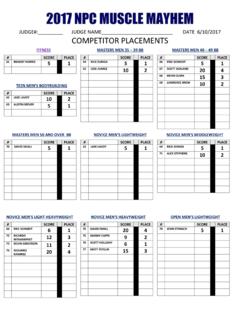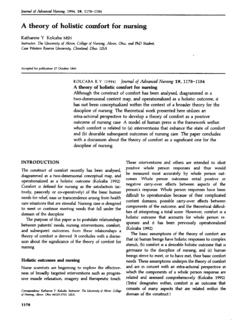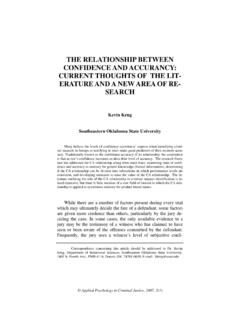Transcription of Measuring Overall Health System Performance for 191 Countries
1 Measuring Overall Health System Performance . FOR 191 Countries . Ajay Tandon, Christopher JL murray Jeremy A Lauer David B Evans GPE Discussion Paper Series: No. 30. EIP/GPE/EQC. World Health Organization 1. Introduction Performance of Health systems has been a major concern of policy makers for many years. Many Countries have recently introduced reforms in the Health sector with the explicit aim of improving Performance (1,2). There exists an extensive literature on Health sector reform, and recent debates have emerged on how best to measure Performance so that the impact of reforms can be assessed (3). Measurement of Performance requires an explicit framework defining the goals of a Health System against which outcomes can be judged and Performance quantified (4). In a previous paper, Evans et al. (5) describe how the Performance of Countries in terms of meeting one important goal that of maximising population Health can be measured.
2 In this companion paper, we assess the Performance of Countries in terms of achieving a broader set of Health System outcomes. In addition to considering Health , we include attainment in terms of 4 other indicators linked to the intrinsic goals of a Health System . The analytical framework used for characterising the goals of a Health System is derived from murray and Frenk (6). They differentiate intrinsic goals of the Health System from instrumental goals. In their framework, an intrinsic goal is one: (a) whose attainment can be raised while holding other intrinsic goals constant ( , there is at least partial independence among the different intrinsic goals), and (b) raising the attainment of which is in itself desirable, irrespective of any other considerations. Instrumental goals, on the other hand, are goals that are pursued to attain the instrinsic goals. murray and Frenk identify three intrinsic goals of a Health System (Figure 1).
3 Health System goals Level Distribution Health . Efficiency Responsiveness . Fairness in financing . Quality Equity Figure 1: Health System Goals The first is improvement in the Health of the population (both in terms of levels attained and distribution). The second is enhanced responsiveness of the Health System to the legitimate expectations of the population. Responsiveness in this context explicitly refers 2. to the non- Health improving dimensions of the interactions of the populace with the Health System , and reflects respect of persons and client orientation in the delivery of Health services, among other As with Health outcomes, both the level of responsiveness and its distribution are important. The third intrinsic goal is fairness in financing and financial risk protection. The aim is to ensure that poor households should not pay a higher share of their discretionary expenditure on Health than richer households, and all households should be protected against catastrophic financial losses related to ill Methodologically, Overall Health System Performance in relation to this broader set of goals is assessed in a similar fashion as described in Evans et al.
4 (5). Specifically, Overall Performance measures how well a country achieves all five goals of the Health System simultaneously, relative to the maximum it could be expected to achieve given its level of resources and non- Health System determinants. Adjustment is also made for the fact that Overall goal attainment may not be zero in the absence of a modern Health System . The framework of frontier production functions (a concept typically used in the measurement of the technical efficiency of firms and farms) is applied, in which the Health System as a whole is viewed as a macro-level production unit. The concept is illustrated in Figure 2. The vertical axis measures Overall goal attainment and inputs are measured on the horizontal axis. 100. Maximum possible 80. Overall goal attainment c 60. b 40. Minimum 20. a 0. 2 4 6 8. Inputs to Overall goal Figure 2: Health System Performance ( Overall Efficiency). The upper line represents the frontier, or the maximum possible level of attainment that can be achieved for given levels of inputs.
5 The lower line, labelled minimum , represents the minimum level of attainment that would exist even in the absence of any Health System inputs ( , the entire population will not be dead in the absence of a functioning Health System ). Assume a country is observed to achieve (a+b) units of the Overall goal attainment. murray and Frenk define Overall System Performance as b/(b+c). This indicates what a System is achieving relative to its potential at given input levels. 1. Health -improving responsiveness dimensions of the System would be included in the attainment of the goal of improving population Health . See de Silva et al. (18) for additional details. 2. See murray et al. (19) for details. 3. The idea is very similar to that of technical efficiency in the frontier production function Accordingly, we use the term Overall efficiency to refer to Overall Health System Performance in the remainder of this paper. 2. Estimation Methods a) Composite Index In order to assess Overall efficiency, the first step was to combine the individual attainments on all five goals of the Health System into a single number, which we call the composite index.
6 The composite index is a weighted average of the five component goals specified above. First, country attainment on all five indicators ( , Health , Health inequality, responsiveness-level, responsiveness-distribution, and fair-financing) were rescaled restricting them to the [0,1] interval. Then the following weights were used to construct the Overall composite measure: 25% for Health (DALE), 25% for Health inequality, for the level of responsiveness, for the distribution of responsiveness, and 25% for fairness in financing. These weights are based on a survey carried out by WHO to elicit stated preferences of individuals in their relative valuations of the goals of the Health The idea of using a weighted average as an index of several goals is not new. A recent example is the Human Development Index (HDI), an index based on the average of three indicators: longevity, educational attainment (including literacy and enrolment), and income per capita.
7 (7). The HDI is commonly used to assess the state of development of a country. Factors such as Health and educational levels of the populace are not viewed as instrumental goals aimed at achieving higher productivity and thereby higher income levels, but are viewed as intrinsic goals of A similar idea underlies the construction of the composite index as a measure of the Overall attainment of the intrinsic goals of the Health System . Figure 3 reports the rank correlation between attainment on each of the individual components and attainment on the Overall composite index for the 191 Countries which are members of the World Health Organization (WHO) in 1997. 3. Technical efficiency is typically defined as (a+b)/(a+b+c) in Figure 2. The primary difference between Performance and technical efficiency is that the former accounts for the non-zero outcome even in the absence of inputs. 4. See Gakidou et al. (20) for details of the survey.
8 5. For an extension of the HDI that incorporates inequalities in income, education, and Health , see Hicks (21). 4. Responsiveness Level 191. Responsiveness Distribution 1. Fair Finance 191. Health Inequality 1. DALE. 191. COMPOSITE. 1. 1 191 1 191 1 191. Figure 3: Rank Correlation, Individual Goal Attainment versus Composite Attainment As can be seen from the bottom row of Figure 3, the ranks on DALE and Health inequality are the most highly correlated with the Overall composite, with Countries which are ranked high on these two components also ranking high on the composite index. This is likely a product of the relatively high rank correlation between some of the goals, , Countries which rank high on levels of Health also seem to do well on level of responsiveness. Rankings on responsiveness level are also highly correlated with responsiveness distribution, as are rankings on Health level with Health distribution. Rankings on fair financing do not seem to be correlated with ranks on any of the other components.
9 This implies that Countries which have major inequalities in Health or responsiveness are equally as likely to score well on fair financing as Countries which have less inequality in these variables. And Countries which achieve relatively high levels of Health are no less likely to have unfair financial systems as Countries that achieve relatively low Health outcomes. For the purposes of this analysis, the weights used in the construction of the composite index have been used consistently, , without considering uncertainty in the valuations of the different components. See murray et al. (8) for additional details regarding the weighting scheme and a sensitivity analysis of the impact of changes in these weights on the Overall attainment of the Health System as measured by the composite index. b) Methodology The econometric methodology for Measuring efficiency on the composite index ( , Overall efficiency) is identical to that for Measuring efficiency on Health [See Evans et al.]
10 (5) for more details]. The problem, from an econometric standpoint, is the estimation of the maximum attainable composite index (the frontier) given resource inputs and other non Health - System determinants of goal attainment. Since this frontier is not directly observable, one way to identify it is to estimate it from the data. There is a large literature on this topic, especially in the areas of agricultural and industrial economics. For reasons elaborated in Evans et al. (5), we chose to use a fixed-effects panel data model in the 5. estimation of the frontier. The econometric methodology of the fixed-effects model is elaborated below. Estimation of the minimum level of goal attainment in the absence of a Health System is described later. Consider a functional relationship where the simultaneous attainment of the goals of the Health systems are a function of resource inputs and other non- Health System determinants. In equation form, this can be written as: Yit = + X it + vit ui.
















